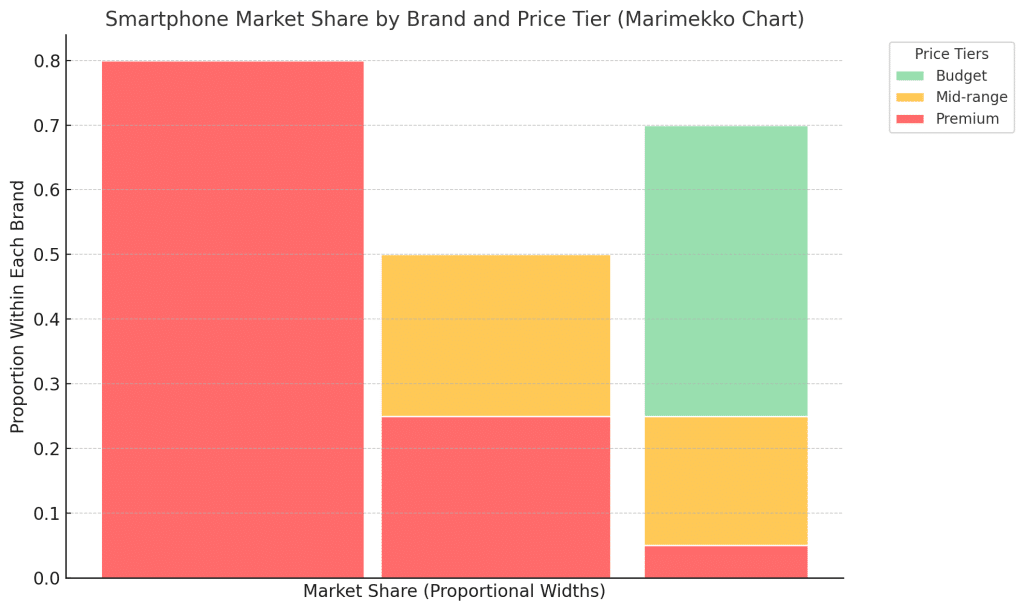
The Marimekko chart is highly useful for companies because it provides a better view of data in a visually intuitive format, which allow businesses to analyze and communicate complex relationships. Let’s review why this chart is so valuable.
What Is a Marimekko Chart?
A Marimekko chart can also be known as a mekko chart and it is a type of bar chart where the width of each bar represents one dimension of data, like a category’s size, while the height of each segment in a bar represents the proportions of subcategories within that category.
It’s used to show absolute values through width and percentages through height in one chart.
The Marimekko chart gets its name from the Finnish textile and fashion company Marimekko, which is known for its bold, colorful, and geometric patterns. The chart resembles the designs created by the company, with its stacked and proportionally sized segments resembling Marimekko’s signature block-style motifs.
The name has become a widely recognized way to refer to this type of proportional and stacked bar chart, emphasizing its visual appeal and ability to communicate multiple dimensions of data in an effective way.
Marimekko Chart Example: Smartphone Market
To understand the marimekko chart in action, let’s analyze the global smartphone market in a simple way. Let’s start by comparing market share by brand. We will use Apple, Samsung, and Xiaomi as examples, and within each brand, how sales are distributed across price tiers (budget, mid-range, premium).
Here’s how the data might look:
| Brand | Market Share (%) | Budget (%) | Mid-range (%) | Premium (%) |
|---|---|---|---|---|
| Apple | 40% | 0% | 20% | 80% |
| Samsung | 35% | 25% | 50% | 25% |
| Xiaomi | 25% | 70% | 25% | 5% |
And this is what the data could look like in a Marimekko chart.

In this case, the Marimekko chart ideal for showing both market dominance and subcategory contributions.
Width tells us absolute market size: Apple has the largest share (40%), followed by Samsung (35%) and Xiaomi (25%).
Height within each bar tells us proportions: For example, almost all of Apple’s sales come from premium phones, while Xiaomi dominates the budget segment.
Importance of Marimekko Chart
The Marimekko chart shows two pieces of information at the same time: the width of the bars represents one data point, and the height of the segments within the bars shows another data point. This lets you see both the big picture and the details that makes up each category all in one chart.
Market segmentation with a Marimekko chart allows companies to see how their market is divided across different categories and subcategories. For example, a company could use the chart to compare the performance of various brands in different regions or customer demographic data.
The width of each bar would show the overall size of the segment like total sales in each region, while the height of the segments within the bar would represent the breakdown of subcategories like product types or customer age groups. This helps businesses identify which segments are performing well, where their strengths lie, and areas where they might have opportunities to grow.
How to Interpret Marimekko Charts
Marimekko charts are great for visualizing data with two dimensions. When used correctly, we can gather insights into overall category sizes and subcategory contributions. Here’s how to interpret them effectively:
- The width of each bar in a Marimekko chart should represents the proportional value of a category relative to the total. For example, in a chart analyzing market share, the width of a bar shows how much of the market a specific brand owns. A wider bar indicates a larger share, making it easy to see which categories dominate the data set.
- The height of each segment within a bar reflects the proportion of subcategories within that category. For instance, a segment might show how a brand’s sales are divided across price tiers like budget, mid-range, and premium, as we learn in the example before. Taller segments highlight a more significant contribution from a specific subcategory, giving us a deeper understanding of what drives the category’s total value.
- To analyze the chart, compare the widths of the bars to identify overall dominance and the heights of the segments to understand the composition within each category. For example, a wide bar with one tall segment might indicate that a brand dominates the market through one strong subcategory, while a narrower bar with evenly distributed segments suggests more balanced contributions across subcategories.
- Look for patterns or imbalances in the chart. Consistently tall segments across multiple bars could indicate a trend, while a single dominating segment might reveal dependency on one subcategory. These insights can help identify strengths, weaknesses, and opportunities for growth within the data.
Comparing dimensions allow us to identify trends, imbalances, and areas for strategic focus, which makes this chart an excellent option for comprehensive data analysis.
Conclusion
Marimekko charts complement other features such as cross-tabulation, pivot tables, and predictive analytics. They’re particularly useful for resource allocation, strategic decision-making, and stakeholder presentations, as they simplify the communication of complex insights.
It can help visualizing market segmentation, campaign performance, and employee diversity data, for example. Marimekko charts can provide clarity and depth of data analysis.
Remember you can always turn complex, multi-dimensional data into clear and actionable insights. QuestionPro makes it easy to create visually compelling Marimekko charts that drive smarter decisions.
Start exploring advanced analytics today and find what better fit your needs—Request a free demo and see how QuestionPro can transform the way you visualize and act on your data!







